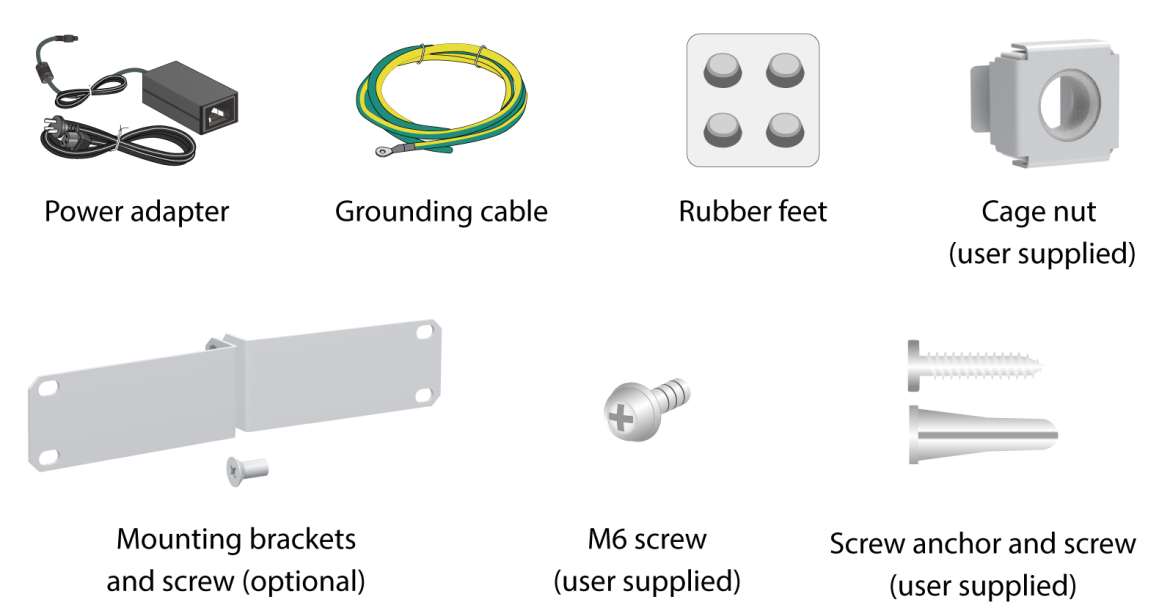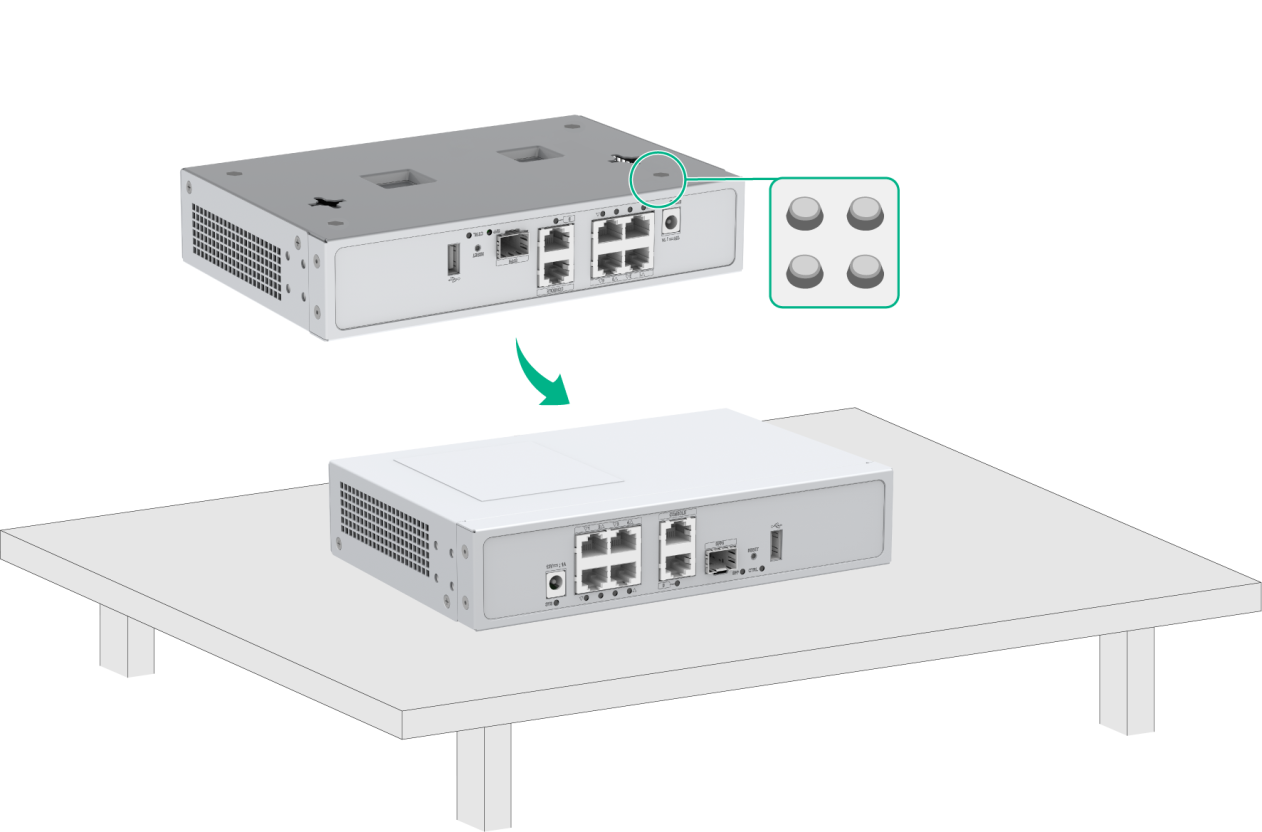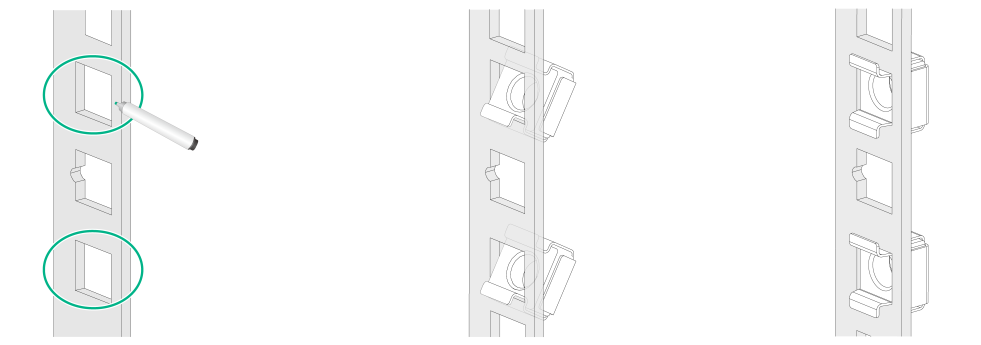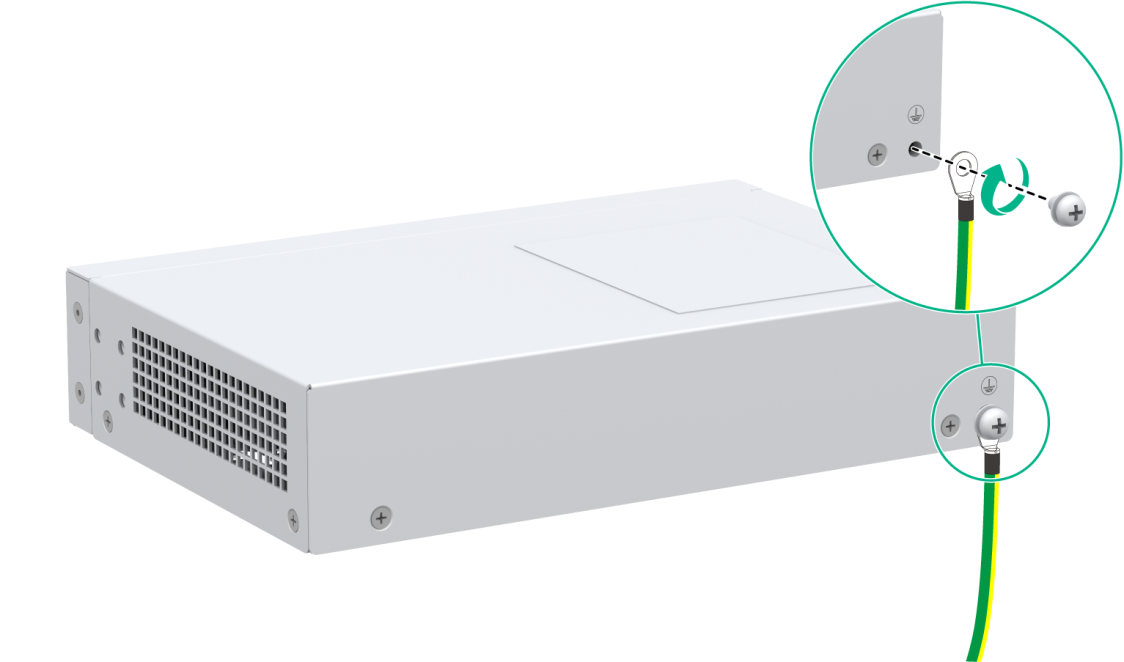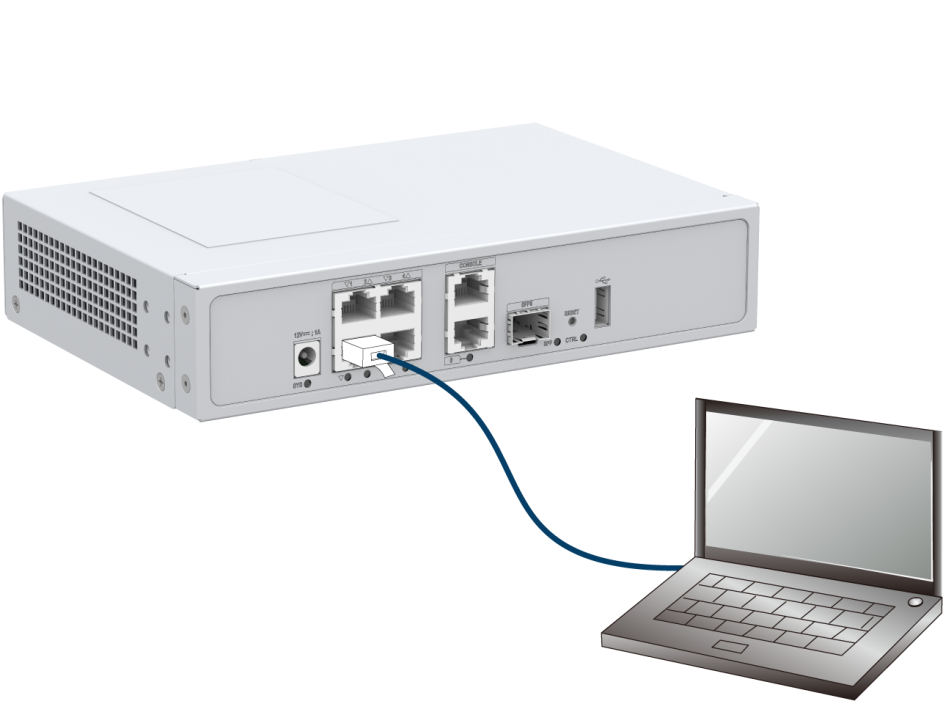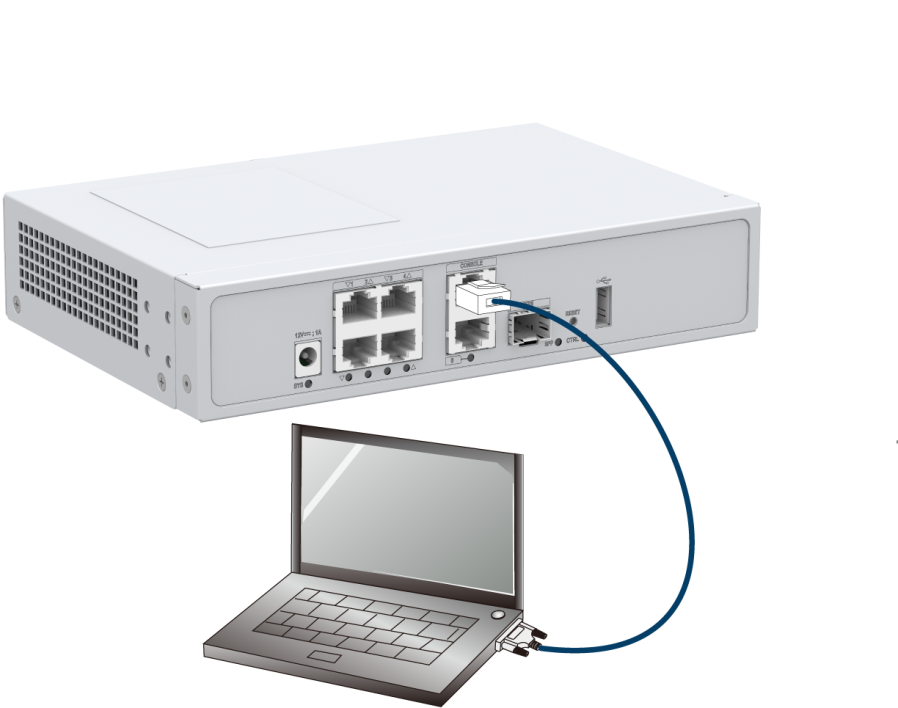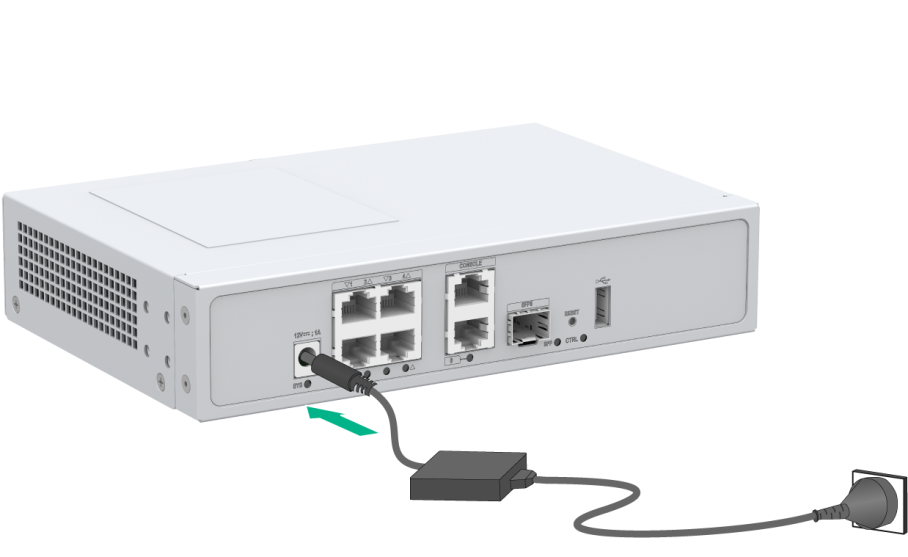- Table of Contents
- Related Documents
-
| Title | Size | Download |
|---|---|---|
| 01-Text | 1000.24 KB |
Contents
General safety recommendations
Examining the installation site
Installation accessories and tools
Mounting the router on a workbench
Installing the router in a rack
Connecting Ethernet interface cables
Connecting the console cable and setting terminal parameters
Setting configuration terminal parameters
Accessing the router for the first time
No display on the configuration terminal
Garbled display on the configuration terminal
No response from the serial port
Restoring the factory settings
1 Preparing for installation
H3C MSR600 router series has one model: MSR610.
Safety recommendations
To avoid any equipment damage or bodily injury, read the following safety recommendations before installation. Note that the recommendations do not cover every possible hazardous condition.
Safety symbols
When reading this document, note the following symbols:
![]() WARNING means an alert that calls attention to important information that if
not understood or followed can result in personal injury.
WARNING means an alert that calls attention to important information that if
not understood or followed can result in personal injury.
![]() CAUTION means an alert that calls attention to important information that if
not understood or followed can result in data loss, data corruption, or damage
to hardware or software.
CAUTION means an alert that calls attention to important information that if
not understood or followed can result in data loss, data corruption, or damage
to hardware or software.
General safety recommendations
· Keep the router and installation tools away from walk areas.
· Place the router in a dry and flat location and make sure anti-slip measures are in place.
· Remove all external interface cables and power cords before moving the router.
Electricity safety
· Locate the power switch of the power source before installation. Shut off the power immediately if an accident occurs.
· Make sure the router is reliably grounded.
· Connect the interface cables correctly.
· Use an uninterrupted power supply (UPS).
· Always make sure the power has been disconnected during installation or replacement.
ESD prevention
|
WARNING! Check the resistance of the ESD wrist strap for safety. The resistance reading should be in the range of 1 to 10 megohm (Mohm) between a human body and the ground. |
To prevent electrostatic discharge (ESD), follow these guidelines:
· Make sure the router and the floor are reliably grounded.
· Keep the equipment room clean to reduce the negative effects of dusts and particles.
· Maintain the humidity and temperature levels in the acceptable range.
· Always wear an ESD wrist strap. Make sure the wrist strap makes good skin contact and is reliably grounded.
No ESD wrist strap is provided with the router. Prepare it yourself.
To attach an ESD wrist strap:
1. Wear the wrist strap on your wrist.
2. Lock the wrist strap tight around your wrist to maintain good contact with the skin.
3. Secure the wrist strap lock and the alligator clip lock together.
4. Attach the alligator clip to the rack or workbench where the router is installed.
Examining the installation site
The router can only be used indoors. To ensure correct operation and a long lifespan for your router, the installation site must meet the requirements in this section.
Temperature and humidity
Maintain the temperature and humidity in the equipment room as described in Table1-1.
· Lasting high relative humidity can cause poor insulation, electricity leakage, mechanical property change of materials, and metal corrosion.
· Lasting low relative humidity can cause washer contraction and ESD and bring problems including loose mounting screws and circuit failure.
· High temperature can accelerate the aging of insulation materials and significantly lower the reliability and lifespan of the router.
Table1-1 Temperature/humidity requirements in the equipment room
|
Item |
Requirement |
|
Operating temperature |
0°C to 45°C (32°F to 113°F) |
|
Operating humidity |
5% RH to 95% RH, noncondensing |
Cleanliness
Dust buildup on the chassis might result in electrostatic adsorption, which causes poor contact of metal components and contact points, especially when indoor relative humidity is low. In the worst case, electrostatic adsorption can cause communication failure.
Table1-2 Dust concentration limit in the equipment room
|
Substance |
Concentration limit (particles/m3) |
|
Dust particles |
≤ 3 x 104 (No visible dust on the tabletop in three days) |
|
NOTE: Dust diameter ≥ 5 µm |
|
The equipment room must also meet strict limits on salts, acids, and sulfides to eliminate corrosion and premature aging of components, as shown in Table1-3.
Table1-3 Harmful gas limits in an equipment room
|
Gas |
Maximum concentration (mg/m3) |
|
SO2 |
0.2 |
|
H2S |
0.006 |
|
NH3 |
0.05 |
|
NO2 |
0.04 |
|
Cl2 |
0.01 |
Cooling
The router uses passive cooling. For better heat dissipation and cooling of the router, follow these guidelines:
· Keep the air vents unblocked. Maintain a minimum clearance of 100 mm (3.94 in) around the air vents.
· Make sure the installation site has a good ventilation system.
EMI
All electromagnetic interference (EMI) sources, from outside or inside of the router and application system, adversely affect the router in the following ways:
· A conduction pattern of capacitance coupling.
· Inductance coupling.
· Electromagnetic wave radiation.
· Common impedance (including the grounding system) coupling.
To prevent EMI, perform the following tasks:
· Take measures against interference from the power grid.
· Do not use the grounding equipment of the router together with the grounding equipment or lightning-prevention equipment of power equipment, and keep the router far away from them.
· Keep the router far away from high-power radio launchers, radars, and equipment with high frequency or high current.
· Use electromagnetic shielding when necessary.
Lightning protection
To protect the router from lightning, follow these guidelines:
· Make sure the router is reliably grounded by using a grounding cable.
· Make sure the power receptacle is reliably grounded.
· Install a lightning protector at each power input end.
Installation accessories and tools
Installation accessories
Figure1-1 Installation accessories
|
IMPORTANT: To wall-mount the router, you must prepare screw anchors and screws. Make sure the screw anchors and screws meet the following requirements: · The screw length is no less than 16 mm (0.63 in). · The screw thread diameter is between 3 mm and 3.5 mm (0.12 in to 0.14 in). · The screw head diameter is between 6 mm and 8 mm (0.24 in to 0.32 in). · The screw anchors are compatible with the screws. |
Installation tools
No installation tools are provided with the router. Prepare them yourself as required.
Figure1-2 Installation tools and equipment
Pre-installation checklist
|
Item |
Requirements |
Result |
|
|
Installation site |
Ventilation |
· There is a minimum clearance of 100 mm (3.94 in) around the air inlet and outlet vents. · An adequate ventilation system is available at the installation site. |
|
|
Temperature |
0°C to 45°C (32°F to 113°F) |
|
|
|
Relative humidity |
5% RH to 95% RH (noncondensing) |
|
|
|
Cleanness |
Dust concentration ≤ 3 × 104 particles/m3 (no visible dust on the tabletop over three days) |
|
|
|
ESD prevention |
· The router and floor are reliably grounded. · The equipment room is dust-controlled. · Humidity and temperature are maintained at acceptable levels. · Wear an ESD wrist strap or ESD gloves and ESD clothing when touching a circuit board. |
|
|
|
EMI prevention |
· Take measures against interference from the power grid. · Do not use the grounding equipment of the router together with the grounding equipment or lightning-prevention equipment of power equipment, and keep the router far away from them. · Keep the router far away from high-power radio launchers, radars, and equipment with high frequency or high current. · Electromagnetic shielding is used as required. |
|
|
|
Lightning protection |
· The router is reliably grounded. · The power receptacle is reliably grounded. · (Optional.) Port lightning protectors are available. A signal lightning arrester is required at the input end of an external signal cable. · (Optional.) Power lightning protectors are available. |
|
|
|
Electricity safety |
· A UPS is available. · The external power switch is located so to shut off the power immediately when an accident occurs. |
|
|
|
Workbench |
· The workbench is stable. · The workbench is reliably grounded. |
|
|
|
Safety precautions |
· The router is far away from any sources of heat or moisture. · The emergency power switch in the equipment room is identified and accessible. |
|
|
|
Tools |
· Installation accessories supplied with the router are ready. · User-supplied tools are ready. |
|
|
|
Reference |
· Documents shipped with the router are available. · Online documents are available. |
|
|
2 Installing the router
|
WARNING! To avoid injury, do not touch bare wires, terminals, or parts with high-voltage hazard signs. |
|
IMPORTANT: · The barcode on the router chassis contains product information that must be provided to local sales agent when you return a faulty router for repair. · Keep the tamper-proof seal on a mounting screw on the chassis cover intact, and if you want to open the chassis, contact H3C for permission. Otherwise, H3C shall not be liable for any consequence. |
Installation prerequisites
· You have read "Preparing for installation" carefully.
· All requirements in "Preparing for installation" are met.
Installation flowchart
The following installation options are available for the router:
· Workbench mounting.
· Wall mounting.
· Rack mounting.
Determine the installation method according to the installation environment. Follow the installation flowchart shown in Figure2-1 to install the router.
Figure2-1 Installation flowchart
Installing the router
Mounting the router on a workbench
|
IMPORTANT: · Make sure the workbench is clean, stable, and reliably grounded. · Maintain a minimum clearance of 100 mm (3.94 in) around the router for heat dissipation. · Do not place heavy objects on the router. |
To mount the router on a workbench:
1. Place the router upside down on the workbench and attach the rubber feet to the four round holes in the chassis bottom.
2. Place the router upside up on the workbench.
Figure2-2 Mounting the router on a workbench
Mounting the router on a wall
1. Mark two screw hole locations on the wall. Make sure the holes are level and the distance between the two holes is 152 mm (5.98 in).
2. Drill holes with a minimum depth of 22 mm (0.87 in) in the marked locations.
3. Hammer an anchor into each hole until the anchor is flush with the wall.
4. Drive a screw into each anchor and make sure the screw protrudes a minimum of 1.5 mm (0.06 in) from the wall.
5. Hang the router on the screws.
Position the router so the network interfaces face downwards, and the sides with ventilation openings are perpendicular to the ground, as shown in Figure2-3.
Figure2-3 Wall-mounting the router
Installing the router in a rack
|
CAUTION: The mounting brackets can support only the weight of the router. Do not place objects on the router. |
No mounting brackets or screws are provided with the router. Prepare them yourself as required.
To install the router in a rack:
1. Use a front mounting bracket to mark the cage nut installation holes in the front rack posts, and then install cage nuts into the marked square holes. See Figure2-4.
Figure2-4 Installing cage nuts
2. Attach mounting brackets to both sides of the router, as shown in Figure2-5.
Figure2-5 Attaching mounting brackets to the router
3. Use M6 screws to attach the mounting brackets on the router to the front rack posts, as shown in Figure2-6.
Figure2-6 Securing the router to the rack
Grounding the router
|
CAUTION: · Correctly connecting the grounding cable is crucial to lightning protection and EMI protection. When you install and use the router, first ground the router reliably. · Ensure a minimum resistance of 5 ohms between the router and the ground. |
To ground the router:
1. Remove the grounding screw from the grounding hole in the chassis.
2. Use the grounding screw to attach the ring terminal of the grounding cable to the grounding hole.
3. Use a screwdriver to fasten the grounding screw.
4. Connect the other end of the grounding cable to the grounding strip.
Figure2-7 Connecting the grounding cable to the router
Connecting Ethernet interface cables
1. Connect one end of the cable to an Ethernet port on the router.
2. Connect the other end of the cable to the Ethernet port on a host.
3. Examine the port LEDs on the router. For more information about the LEDs, see H3C MSR600 Router Series Hardware Information and Specifications.
Figure2-8 Connecting an Ethernet cable
Connecting the console cable and setting terminal parameters
Connecting the console cable
|
CAUTION: The serial ports on PCs do not support hot swapping. To connect a PC to an operating router, first connect the PC end. To disconnect a PC from an operating router, first disconnect the router end. |
To connect the console cable:
1. Select a configuration terminal, which can be an ASCII terminal with an RS-232 serial port or a PC. (A PC is more commonly used.)
2. Connect the DB-9 connector (female) of the console cable to the RS-232 serial port on the configuration terminal and the RJ-45 connector to the console port of the router.
Figure2-9 Connecting the console cable
Setting configuration terminal parameters
To access the device from the console port, you must run a terminal emulator program (HyperTerminal, PuTTY, or Tera Term) on the configuration terminal. For information about using a terminal emulator program, see the program's user guide.
The following are the required terminal settings:
· Baud rate—9600.
· Data bits—8.
· Stop bits—1.
· Parity—None.
· Flow control—None.
Connecting the power adapter
|
CAUTION: To avoid power adapter damage, use the power adapter provided with the router. |
To connect the power adapter:
1. Make sure the router is reliably grounded.Connect the DC output plug of the power adapter to the power adapter receptacle on the router.
2. Connect the power adapter to the AC receptacle.
Figure2-10 Connecting the power adapter
Verifying the installation
After you complete the installation, verify the following information:
· There is enough space around the router for heat dissipation.
· The router is installed securely.
· USB devices are installed correctly.
· The router and power source are grounded reliably.
· The power source is as required by the router.
· The router is connected correctly to the configuration terminal and other devices. Parameters are configured correctly on the configuration terminal.
Accessing the router for the first time
|
WARNING! Before powering on the router, locate the switch for the power source so that you can cut off power promptly in case of an emergency. |
For a router starting with empty configuration, you must press Ctrl+D to access the CLI.
To access the router for the first time:
1. Verify that the installation and configuration environment is as described in "Verifying the installation."
2. Power on the router.
3. During the booting process, verify the following items:
¡ The LEDs on the front panel indicate normal operation. For more information about the LEDs, see H3C MSR600 Router Series Hardware Information and Specifications.
¡ The configuration terminal displays information correctly.
The router first initializes its memory at startup and then runs BootWare.
System is starting...
Press Ctrl+D to access BASIC-BOOTWARE MENU
Booting Normal Extended BootWare
Press Ctrl+T to start heavy memory test
****************************************************************************
* *
* H3C MSR610 BootWare, Version 1.66 *
* *
****************************************************************************
Copyright (c) 2004-2022 New H3C Technologies Co., Ltd.
Compiled Date : Jan 25 2022
Memory Type : DDR3 SDRAM
Memory Size : 1024MB
PCB Version : Ver.A
BootWare Validating...
Press Ctrl+B to access EXTENDED-BOOTWARE MENU...
Loading the main image files...
Loading file flash:/msr610-cmw710-system-a6728p21.bin.......................
......................................................Done.
Loading file flash:/msr610-cmw710-security-a6728p21.bin...Done.
Loading file flash:/msr610-cmw710-voice-a6728p21.bin...Done.
Loading file flash:/msr610-cmw710-data-a6728p21.bin.......Done.
Loading file flash:/msr610-cmw710-wifidog-a6728p21.bin...Done.
Loading file flash:/msr610-cmw710-wwd-a6728p21.bin...Done.
Loading file flash:/msr610-cmw710-boot-a6728p21.bin..........Done.
Image file flash:/msr610-cmw710-boot-a6728p21.bin is self-decompressing.....
............................................................................
............................................................................
............................................................................
............................................................................
............................................................................
............................................................................
............................................................................
............................................................................
................................................Done.
System image is starting...
Cryptographic algorithms tests passed.
Startup configuration file doesn't exist or is invalid.
Performing automatic configuration... Press CTRL_C or CTRL_D to break.
Automatic configuration attempt: 1.
Not ready for automatic configuration: no interface available.
Waiting for the next...
Automatic configuration attempt: 2.
Interface used: GigabitEthernet0/0.
Enable DHCP client on GigabitEthernet0/0.
GigabitEthernet0/0 failed to obtain IP address.
Waiting for the next...
Automatic configuration is aborted.
Line con0 is available.
Press ENTER to get started.
4. Press Enter. The router is ready to configure when you see the following prompt:
<Sysname>
5. Configure basic settings for the router.
For information about configuring basic settings for the router, see the configuration guide.
3 Troubleshooting
|
IMPORTANT: · The barcode on the router chassis contains product information that must be provided to local sales agent when you return a faulty router for repair. · Keep the tamper-proof seal on a mounting screw on the chassis cover intact, and if you want to open the chassis, contact H3C for permission. Otherwise, H3C shall not be liable for any consequence. |
Power supply failure
Symptom
The router cannot be powered on and the LEDs on the front panel are off.
Solution
To resolve the issue:
1. Verify that the power cord connects the router to the power source correctly.
2. Verify that the power source is operating correctly.
3. Verify that the power cord is in good condition.
4. If the issue persists, contact H3C Support.
No display on the configuration terminal
Symptom
The configuration terminal does not have display when the router is powered on.
Solution
To resolve the issue:
1. Verify that the power system is operating correctly.
2. Verify that the console cable is connected correctly to the specified serial port on the configuration terminal.
3. Verify that the following settings are configured for the terminal:
¡ Baud rate—9600.
¡ Data bits—8.
¡ Parity—none.
¡ Stop bits—1.
¡ Flow control—none.
¡ Emulation—VT100.
4. Verify that the console cable is in good condition.
5. If the issue persists, contact H3C Support.
Garbled display on the configuration terminal
Symptom
The configuration terminal has garbled display when the router is powered on.
Solution
To resolve the issue:
1. Verify that the following settings are configured for the terminal:
¡ Baud rate—9600.
¡ Data bits—8.
¡ Parity—None.
¡ Stop bits—1.
¡ Flow control—None.
2. If the issue persists, contact H3C Support.
No response from the serial port
Symptom
The serial port on the router does not respond.
Solution
To resolve the issue:
1. Verify that the serial cable is in good condition and the serial port settings are correct.
2. If the issue persists, contact H3C Support.
Restoring the factory settings
Scenario 1
Symptom
When you replace the router, the router password is lost. As a result, you cannot log in to the router and do not know the router configuration.
Solution
Because the router is replaced, you do not need to save the configuration of the router. In this case, you can press the RESET button for more than 4 seconds to reboot the router and restore the factory settings. Then, you can use the username and password shipped with the router to log in to the router.
When the router configuration must be saved and you have a console cable, you can log in to the router from the BootWare menu.
Scenario 2
Symptom
After the configuration is modified, the network connectivity is lost. When you check the configuration, the configuration is very complicated and it is hard to locate the errors. In this case, you must configure the router again.
Solution
If you have not saved any configuration, you can reboot the router by pressing the RESET button for a short time or power off the router.
If you have saved the configuration, delete the configuration file at the CLI, and press the RESET button to restore the factory settings.
Scenario 3
Symptom
The router crashes.
Solution
Press the RESET button for a short time to reboot the router.
Reset button usage guidelines
The router provides the RESET button. You can use the button to reboot the system or restore the factory settings.
· Press the RESET button for a short time to reboot the router.
· Press the RESET button for more than 4 seconds to reboot the router and restore the factory settings.

